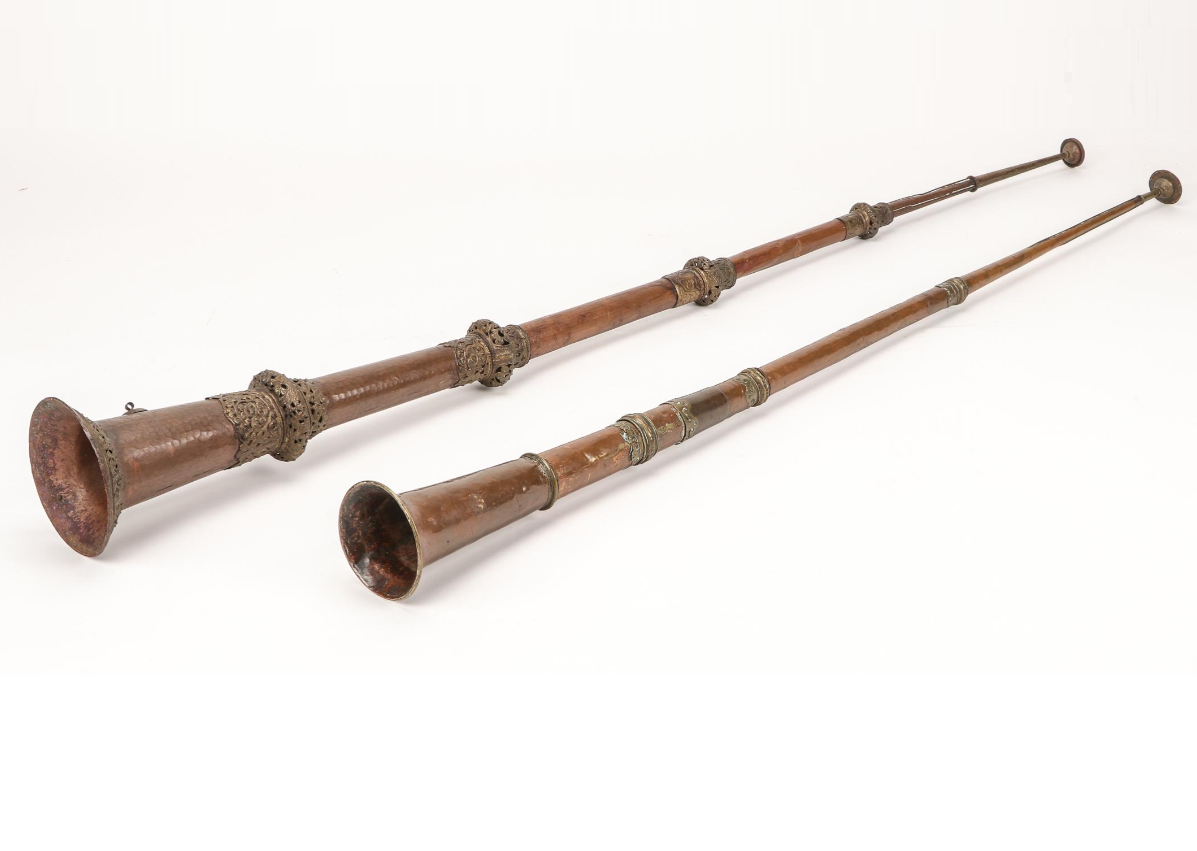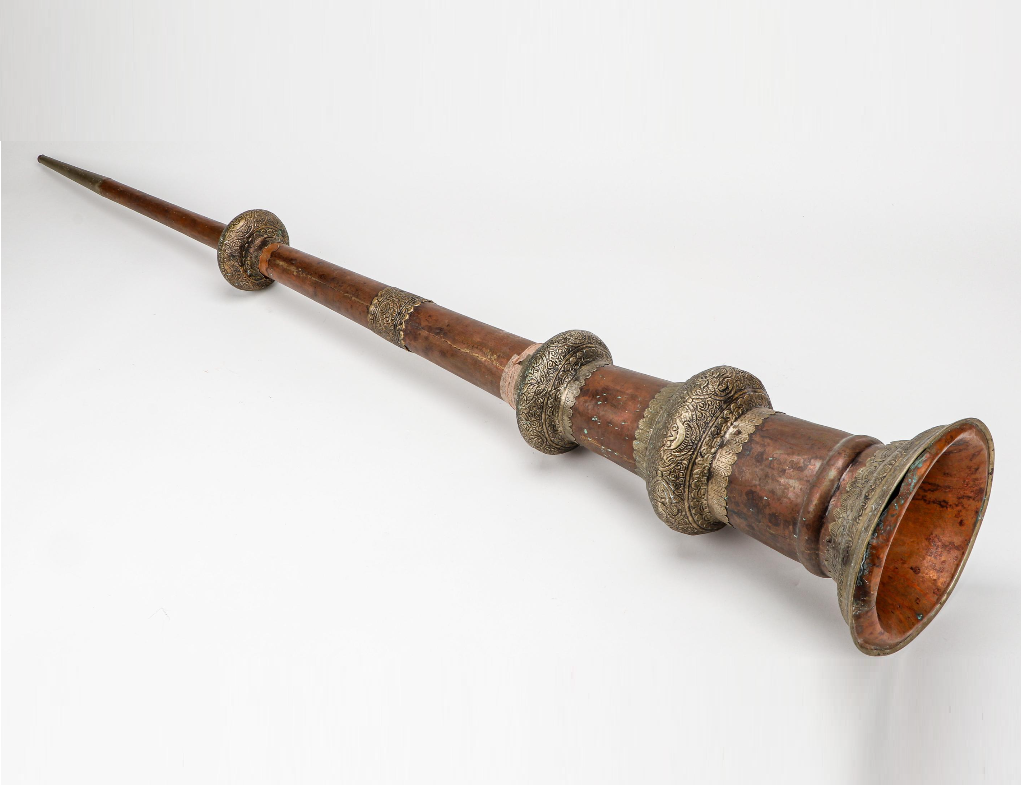Dungchen
Woodwinds
Asia
Between 0 and 1000 AD
Video
The Dungchen (also spelled dung-chen or dung chen) is a traditional Tibetan long trumpet, renowned for its deep, resonant tones. It is one of the most iconic wind instruments used in Tibetan Buddhist ceremonies, producing a powerful and low-pitched sound that can be heard over great distances. This instrument is not just a musical tool but a sacred object, deeply embedded in Tibetan monastic life, rituals, and cultural expressions.
Origin and History
The Dungchen, a long, trumpet-like instrument, has its origins in Tibet, a region in Asia, and dates back to at least the 10th century. It is traditionally used in Tibetan Buddhist rituals, particularly in monasteries and ceremonies. The dungchen is believed to have been influenced by ancient Indian and Central Asian brass instruments, which were introduced to Tibet through cultural exchanges along trade and religious routes. Over the centuries, it became an essential part of Tibetan Buddhist music, often played in pairs or groups to produce deep, resonant tones that symbolize the sound of the Dharma. Today, the dungchen remains an important instrument in Tibetan and Himalayan religious practices, often accompanying chanting, cymbals, and drums in temple rituals.
Construction and Design
The Dungchen is typically made from brass or copper, sometimes adorned with intricate silver and gold inlays. It is characterized by its telescopic design, which allows for portability despite its impressive length. When fully extended, the Dungchen can range between 4 to 20 feet in length, with the longer versions producing deeper and more profound sounds. The bell of the trumpet is often flared, which helps amplify its sound, creating a reverberating and almost otherworldly tone.
Key Features of the Dungchen
Material: Typically made from copper, brass, or silver-plated metals.
Length: Can extend up to 20 feet.
Sections: Designed in telescoping segments for easier transport.
Bell Shape: Large and flared for maximum sound projection.
Ornamentation: Often decorated with religious symbols or intricate engravings.
Playing Technique
The Dungchen requires specialized techniques to produce its characteristic drone-like sound. Unlike Western brass instruments, it does not have valves or keys to alter pitch. Instead, musicians rely on lip tension and breath control to create different tones. Skilled players often use circular breathing, a technique that allows for continuous sound production without breaks.
The instrument is typically played in pairs or larger ensembles, with multiple Dungchen players alternating and harmonizing to create a powerful sonic presence. The deep, resonant tones are intended to invoke a spiritual atmosphere and are often likened to the sound of an elephant’s call.
Role in Tibetan Buddhist Rituals
The Dungchen is a staple instrument in Tibetan Buddhist ceremonies, where it serves a spiritual purpose beyond mere musicality. It is used in morning and evening prayers, ritual dances, meditation sessions, and monastic processions. The deep reverberations of the Dungchen are believed to purify negative energy and summon divine beings. Some specific ritualistic uses include:
- Invocation of Deities: The sound of the Dungchen is thought to call upon protective deities and spiritual beings.
- Marking Sacred Moments: Used to signal significant points in Buddhist ceremonies, such as the beginning of prayer sessions.
- Funeral Rites: Often played during Tibetan Buddhist funeral ceremonies to guide the deceased’s soul on its journey.
- Festivals and Celebrations: Featured in religious festivals like the Great Prayer Festival (Monlam Chenmo).
Symbolism and Cultural Significance
Beyond its auditory impact, the Dungchen holds profound symbolic meaning in Tibetan culture. It represents the voice of the Buddha, carrying prayers and spiritual messages to higher realms. The deep, continuous drone is often compared to the infinite nature of the universe, reminding practitioners of the impermanence of life and the vastness of existence.
In addition, the act of playing the Dungchen is considered a form of meditation, as it requires intense concentration and breath control. Monks often view their performance as a spiritual practice rather than mere musical performance.
Modern Usage and Preservation
In modern times, the Dungchen continues to be played in monasteries, festivals, and even contemporary music settings. However, the preservation of traditional Tibetan instruments like the Dungchen faces challenges due to political and cultural shifts, particularly in regions where Tibetan heritage is under threat.
Efforts to keep the tradition alive include music education programs, cultural preservation initiatives, and international performances that introduce the Dungchen to a global audience. Tibetan musicians and scholars are working to document and archive traditional playing techniques to ensure that future generations can learn and appreciate this sacred instrument.
It is far more than just a long trumpet—it is a spiritual and cultural emblem of Tibetan Buddhism. Its deep, resonant tones have echoed through Tibetan monasteries for centuries, playing a vital role in religious ceremonies, meditative practices, and cultural celebrations. As a sacred instrument, it continues to inspire both monks and musicians worldwide, ensuring that its powerful sound and profound significance endure for generations to come.
FAQ
What type of musical instrument is the Dungchen?
The Dungchen is a traditional Tibetan brass horn, known for its long, telescoping structure. It can extend up to 20 feet in length and produces a deep, resonant sound. It is classified as an aerophone, played by buzzing the lips into its mouthpiece. The instrument is primarily used in Buddhist ceremonial music.
What is the usage of the Dungchen?
The Dungchen is mainly used in Tibetan Buddhist rituals, particularly in monasteries. It signals important religious events, accompanies chanting, and is believed to summon deities. Its powerful sound represents the voice of the Buddha, creating a meditative atmosphere for spiritual practices.
What types of music feature the Dungchen?
The Dungchen is integral to Tibetan Buddhist ceremonial music, often played in monastic ensembles. It is commonly used in ritual chanting, meditation music, and festival processions. The sound blends with cymbals, drums, and other wind instruments, creating a deep, droning ambiance.
 Links
Links
References
Other Instrument
Categories



















